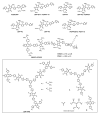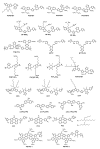Polymeric Dopant-Free Hole Transporting Materials for Perovskite Solar Cells: Structures and Concepts towards Better Performances
- PMID: 34069612
- PMCID: PMC8160825
- DOI: 10.3390/polym13101652
Polymeric Dopant-Free Hole Transporting Materials for Perovskite Solar Cells: Structures and Concepts towards Better Performances
Abstract
Perovskite solar cells are a hot topic of photovoltaic research, reaching, in few years, an impressive efficiency (25.5%), but their long-term stability still needs to be addressed for industrial production. One of the most sizeable reasons for instability is the doping of the Hole Transporting Material (HTM), being the salt commonly employed as a vector bringing moisture in contact with perovskite film and destroying it. With this respect, the research focused on new and stable "dopant-free" HTMs, which are inherently conductive, being able to effectively work without any addition of dopants. Notwithstanding, they show impressive efficiency and stability results. The dopant-free polymers, often made of alternated donor and acceptor cores, have properties, namely the filming ability, the molecular weight tunability, the stacking and packing peculiarities, and high hole mobility in absence of any dopant, that make them very attractive and a real innovation in the field. In this review, we tried our best to collect all the dopant-free polymeric HTMs known so far in the perovskite solar cells field, providing a brief historical introduction, followed by the classification and analysis of the polymeric structures, based on their building blocks, trying to find structure-activity relationships whenever possible. The research is still increasing and a very simple polymer (PFDT-2F-COOH) approaches PCE = 22% while some more complex ones overcome 22%, up to 22.41% (PPY2).
Keywords: dopant-free polymers; hole transporting materials; organic materials; perovskite solar cells.
Conflict of interest statement
The authors declare no conflict of interest.
Figures














References
-
- Nazeeruddin M.K., Snaith H. Methylammonium lead triiodide perovskite solar cells: A new paradigm in photovoltaics. MRS Bull. 2015;40:641–645. doi: 10.1557/mrs.2015.169. - DOI
-
- Kim H.S., Lee C.R., Im J.H., Lee K.B., Moehl T., Marchioro A., Moon S.J., Humphry-Baker R., Yum J.H., Moser J.E., et al. Lead iodide perovskite sensitized all-solid-state submicron thin film mesoscopic solar cell with efficiency exceeding 9% Sci. Rep. 2012;2:591. doi: 10.1038/srep00591. - DOI - PMC - PubMed
Publication types
Grants and funding
LinkOut - more resources
Full Text Sources
Other Literature Sources

